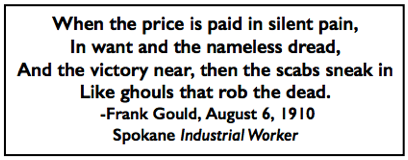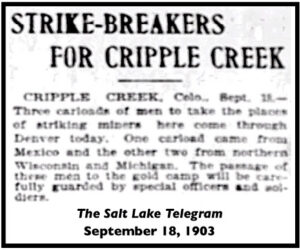 —————
—————
Hellraisers Journal – Saturday September 26, 1903
Cripple Creek District, Colorado – Imported Strikebreakers Escape to Union Hall
Report of Emma F. Langdon of Victor, Colorado:
51 STRIKE BREAKERS ARRIVE IN THE DISTRICT.
On Sept. 18 the much heralded strike breaking miners from the “east’’ arrived in Denver on their way to the district under heavy guard.
When the train carrying these men reached Cripple Creek the soldiers abandoned them, but the mine owners had places provided for their comfort. The newsboys followed them down the street and cried, “scab!” after them. This frightened the mine owners and a detachment of troops was immediately sent from Camp Goldfield to Cripple Creek, going over on the 9 o’clock electric low line from Victor. These soldiers were soon joined by two other companies of infantry and they lined Bennett avenue from First to Third streets and guarded the alleys more particularly. The soldiers’ headquarters were made at the Mining Exchange building, from where they received their orders. Citizens walking along the streets were told to move on and not to loiter.
The Finns and Norwegians, which constituted most of the men brought in—in fact, there was only two Americans among them—and very few who could speak English. The ones who could speak English stated that conditions had been misrepresented to them. They had just finished their work in the harvest fields of northern Michigan and were told that a new gold field had been opened here and that the mine owners wanted men badly. They were informed that in order to get men at once they would pay $3 for eight hours work and that the first men who responded would get the jobs. They were told further that if they did not like the work they would pay their expenses back to their homes and that it would not cost them a cent to get to the district.
There was eighty-seven in the crowd when they reached Denver, but twenty-six of the number pulled away in that city and about nine quit at Colorado Springs, leaving fifty or fifty-one to arrive in the gold camp.
STRIKE BREAKERS CONVERTED TO UNIONISM.
Eighteen of the men shipped into the district from Michigan were at union headquarters Friday night, Sept. 18, and stated that they would not go to work under the conditions here; that matters here had been grossly misrepresented to them. The balance of the fifty-one were taken to the Independence mine in the morning under heavy guard, but when they got to the mine they refused to go below. They were kept there all day and fed at Camp Goldfield.
On Saturday morning, Sept. 19, while the remaining twenty-three imported laborers were being escorted along Bennett avenue, Cripple Creek, by the military, the first shot of the “Cripple Creek District War” occurred when Lieutenant Hartung, of company B, took a shot at one of the imported Finns, Emil Peterson, who had been drawn off by the unions.
The strike breakers were being escorted from Miners’ Exchange hall to the depot by a detachment of company B. At the corner of Second and Bennett avenue Peterson broke through the lines and tried to talk to the strike breakers. He was ordered out by Capt. Frazier. As the man turned away he shouted in an excited manner, in his own tongue, to the others, and the captain called on Lieut. Hartung, “Arrest that man.” Peterson ran up the avenue, and Lieut. Hartung called, “Halt!” three times. The man increased his speed. The officer then sent a bullet after the man, who was now running like a frightened rabbit, his hat falling off in his mad rush for freedom and perhaps unionism.
Saturday morning unionists persuaded eighteen of the imported Finns to desert the mine owners, one of them being the man who was shot at by the lieutenant and whom the private sharp shooter offered to kill if the order was given. Peterson claimed that all of the strikebreakers were induced to come to Colorado by false representation, and the promise of high wages, from $4 to $5 a day being offered.
PETERSON’S AFFIDAVIT.
The following affidavit was made Saturday morning, Sept. 19, by Peterson, the Danish workman who was fired on:
County of Teller, State of Colorado, Emil Peterson, being duly sworn, upon his oath he says.
I am twenty-four years of age. I reside in Denmark; that is my native land. I came to America February 23, 1903. I then went to Fairchilds, Wis. I am not an American citizen. At Fairchilds the Lester Lumber company paid only $26 per month. On the 8th of September I went to Duluth to get work. At Duluth B. B. Gilbert & Co., labor agents, 5 South avenue, west, employed me to go to work in the Colorado gold mines. I was to get from $3 to $5 per day to fire boilers in the mine. I was shipped here from Duluth. Mine owners of Cripple Creek advanced me $18 for car fare. The company would pay this if we contracted to work a month. About seventy-five men were shipped from Duluth. I don’t know how many quit on the way. Others joined at St. Paul, making near 150 altogether. I think that about eighty of these, of whom only five had ever worked in a mine arrived last night, Friday, September 18.
B. B. Gilbert & Co. told us there was no strike in Cripple Creek. They had a newspaper in the office saying, “No strike in gold camp; all men go to work.” At Colorado Springs we discovered there was a strike. Men with spectacles on who said they were mine lessees met us in Colorado Springs and came on with us. I stayed last night at the Rhodes house with a party of ten.
We took breakfast and then went to a building near where the shooting occurred. Here there were many others. The men were lined up and an officer said: “Come on, boys, go to work.” I said out loud in Spanish, “Don’t go to work.” I started to run and he fired at me with a pistol. I ran zigzag to avoid the bullet. He fired once. I got away.
Subscribed and sworn to before me this 19th day of September, 1903.
ABBY C. COLWELL, Notary Public.
My commission expires June 29, 1904.
(Signed) EMIL PETERSON, CARL HANSON.Peterson’s companion, Carl Hanson, made an affidavit to the effect that he had accompanied Peterson from Fairchilds to Duluth and from there to the district and that he saw the soldier shoot at Peterson, etc.
E. D. Whitney also made an affidavit that he saw the shooting and that Peterson had made a correct statement.
This goes to show what the Mine Owners’ Association would resort to in order to accomplish their purpose. Import men here by false representation and after they arrived and discovered true conditions and refused to work try to force them at the point of bayonets to work when all other efforts had failed.
By Tuesday, Sept. 22, all the remaining Finns escaped from the mines where they were forced to work at the point of bayonets had left the city at the expense of unions, be it recorded to the foreigner’s credit. That set of imported men were not naturally born “scabs,” union men are born—not made. To the writer’s mind a natural born “‘scab’’ will leave a good union job and work for less, in order to be what he is naturally—a “scab” on the face of humanity.
[Newsclip and emphasis added.]
Updates on Cripple Creek Strike:
Saturday September 19, 1903 – Cripple Creek, Colorado
-Imported Strikebreakers Find Their Way to the Union Hall
Eighty-seven imported strikebreakers reached Denver yesterday on their way to the Cripple Creek strike zone. But, it seems, the mine owners are having a hard time of it hanging onto their new employees. Realizing that they were brought into Colorado to be turned into scabs, twenty-six deserted in Denver, and nine more in Colorado Springs. Only about fifty actually got off the train at Cripple Creek where the soldiers turned them over to the guards (gunthugs) of the mine owners.
As the new arrivals were marched down the street, the little union newsboys followed them and began to shout, “scabs, scabs!” The shouts of these children so alarmed the mine owners that they recalled the soldiers to provide an escort for their strikebreakers. The soldiers lined the the streets and alleyways, and forced citizens to step aside and to “move on.”
Most of the imported strikebreakers are Finns and Norwegians who speak no English. Among them, however, are two Americans who told a story of lies and deception. Conditions here are not as they were presented. Some of them were recruited from the harvest fields of Michigan and were told that they would be going to work in a newly opened gold field. Nothing was said about a strike in the area.
The new work force was further diminished last evening when eighteen of the men turned up at the Cripple Creek headquarters of the Western Federation of Miners. Early this morning, the remaining workforce was taken to the Independence Mine, but refused to go to work. They were then taken to the military camp at Goldfield and are being held there at this time.
One of the Finns, Emil Peterson, attempted to desert this morning, and was shot at by Lieutenant Hartung of Company B. Peterson was able to escape. Peterson came here from Duluth, Minnesota, having been assured by the employment agency that there was no strike in the area.
Wednesday September 23, 1903 – Cripple Creek District, Colorado
-All Finns Imported as Strikebreakers Have Escaped
All of the Finns who were imported as strikebreakers last week have now managed to escape from the clutches of the military and the mine owners’ gunthugs. They worked under the bayonets of the soldiers, and were forced to scab, but, to their credit, these imported strike breakers were not born to be scabs. They have been provided transportation out of the strike zone by the Western Federation of Miners.
Another rebellious worker, however, was not so lucky. Near the Strong Mine a sentry saw movement in the dark and hollered, “halt.” When the the movement did not cease as commanded, the sentry opened fire. Soon all hell broke loose as other sentries joined in, firing off twenty-five shots in all. The movement in the dark turned out to be a burro, now quite dead. Bullets also came flying into two nearby houses, but we are relieved to report that none of the occupants were injured. We cannot say whether the burro was trying to make his escape, or only lost and wandering about. But the incident does point to the risks taken by those attempting to escape from the mining camps of the Cripple Creek District.
—————
~~~~~~~~~~~~~~~~~~~~~~~~~
SOURCES & IMAGES
Quote Frank Gould Poem Scab, IW p3, Aug 6, 1910
https://www.marxists.org/history/usa/pubs/industrialworker/iw/v2n20-w72-aug-06-1910-IW.pdf
The Cripple Creek Strike, 1903-1904
-by Emma F. Langdon
Victor, CO, 1904
p124-126
https://archive.org/details/cripplecreekstri00lang/mode/1up?view=theater
https://archive.org/details/cripplecreekstri00lang/page/124/mode/1up?view=theater
The Salt Lake Telegram
(Salt Lake City, Utah)
-Sept 18, 1903
https://www.newspapers.com/image/533575448/
See also:
Tag: Emma F Langdon
https://weneverforget.org/tag/emma-f-langdon/
Tag: Cripple Creek Strike of 1903-1904
https://weneverforget.org/tag/cripple-creek-strike-of-1903-1904/
~~~~~~~~~~~~~~~~~~~~~~~~~
Worker’s Song – Dropkick Murphys

